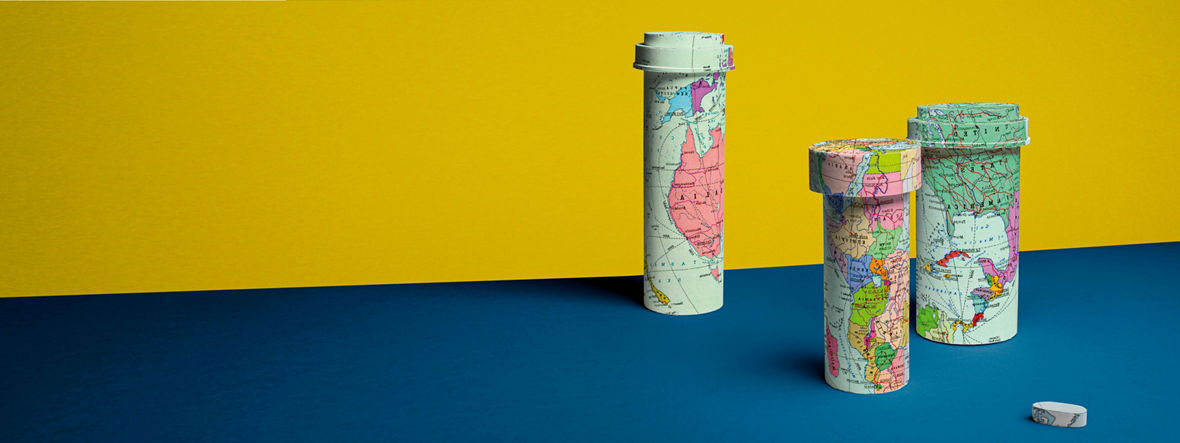The German name is actually absurd, but it’s too late to change it,” says Professor Jörg Breitkreutz, who heads the Institute of Pharmaceutics and Biopharmaceutics at Heinrich Heine University Düsseldorf. He’s talking about the “melting tablets” referred to in German scientific literature, which he has been working with for almost two decades. “They don’t melt at all, either during production or when they are taken,” he says. Nor do they have a smooth melted glaze—on the contrary. ODTs are uncoated and brittle. The special thing about them is that they break up or dissolve quickly in the mouth. That’s why they’re called orally dissolving or orally disintegrating tablets—ODTs for short.
QUICKLY SOLUBLE
Even though Breitkreutz is frustrated by the misleading German name, he’s enthusiastic about this invention itself. “About half of all the new tablets that are currently being developed in the USA are ODTs,” he says.
There are good reasons why the developers are increasingly relying on this method for administering medications. It combines the advantages of a tablet with those of an active ingredient solution: ODTs can be dosed easily and precisely and taken without water. “Most of the new variants dissolve in less than ten seconds, and many even need less than five seconds,” says Breitkreutz. As a result, the active ingredient is quickly available to the body, because when it reaches the stomach it’s already dissolved.
ODTs have clear advantages for patients who find it difficult to swallow conventional tablets. “For example, during an acute attack of migraine patients are often physically incapable of swallowing palliative medications,” he explains. In such cases the stomach literally closes down.
»RXCIPIENTS® has what it takes to improve many more ODT applications«
JOSEPH ZELEZNIK TECHNICAL PRODUCT MANAGER AT THE SPECIALTY CHEMICALS DISTRIBUTOR IMCD
Until now, physicians would often administer muscle relaxants such as diazepam rectally in the form of a gel in order to interrupt epileptic attacks in children. This was a difficult procedure that was unpleasant for the young patients. Breitkreutz has helped to develop ODTs the size of a pinhead, which pose no risk of choking even for babies and toddlers. What’s more, they already transport some of the active ingredient into the body very quickly via the oral mucous membrane. “You put a tablet inside the child’s cheek, stroke the cheek once, and the tablet is gone,” he says.
SUSCEPTIBLE TO MOISTURE
Breitkreutz wrote about medicinal preparations suitable for children in his postdoctoral qualification dissertation back in 2004. “At that time there were hardly any dosage forms that had been specially developed for children,” he recalls. The few that existed were often liquid formulations that were supposed to resemble child-friendly juice. However, these formulations raised problems of their own. For example, the World Health Organization (WHO) criticizes the fact that liquid formulations often require auxiliary substances such as solvents and preservatives or surfactants that are not problematic for adults but could be harmful to children. Besides, juices are more expensive and usually need to be kept refrigerated, because they are less stable than other types of medicine. These are two huge obstacles, especially if the medicine is destined for children in developing and emerging countries. “The WHO and the EU initiative Better Medicines for Children have been key drivers in the development of new ODTs,” says Breitkreutz. This development is still going on.
That’s because many common ODTs still have a crucial disadvantage: There are not very robust, and they are susceptible to moisture. As a result, they have to be packed individually with great care so that they don’t crumble before they can be administered. But the experts at Evonik have come up with a solution based on fumed silica: RXCIPIENTS®.
Evonik took over competence in this area when it acquired the silica division of the US company J.M. Huber three years ago. In Havre de Grace, Maryland, the company produces silicas as ingredients in many types of tablets, including RXCIPIENTS® for ODTs.
J.M. Huber began to work with ODTs at the turn of the millennium. At that time, a US pharmaceutical company was looking for an auxiliary substance for a new tablet for treating schizophrenia. ODTs are very helpful in the treatment of such mental illnesses, because they make it easier to administer medicines reliably. When they are administered under supervision, they cannot be simply spit out.
One of the researchers who followed this development was Dr. Duenwu Hua, a native of Taiwan who had come to the USA in the mid-1980s to gain a doctorate in chemistry. He was hired by J.M. Huber early in the new millennium. “It was actually unusual for our company to receive this inquiry,” Hua recalls. Silica and silicates had been used in tablet production for a long time, for example during the production process in order to create a homogeneous distribution of active ingredients that would make it possible to ensure a precise dosage in each tablet. However, back then they were hardly used at all in ODTs.

Even today, disintegrating aids are the key ingredients that make ODTs dissolve in the mouth within seconds. One commonly used disintegrating aid is an indigestible polymer called crospovidone. When it comes into contact with water or saliva, it swells up and bursts the tablet.
Such disintegrating aids work optimally only if the tablets themselves are not too stable. As a result, many ODTs cannot be sold in conventional blister packaging. They would simply crumble as they were being pressed out. The loose packaging in orange plastic containers with covers that is commonly used in the USA is especially problematic, because if the container is shaken the tablets simply shatter. Besides, regular opening of the container repeatedly lets moisture in, so the tablets disintegrate while they’re still inside the packaging. That’s why ODTs are often packaged in peel-off blisters with a foil that the patient has to remove with care. However, this is not always easy, particularly for older patients.
Thus the challenge was clearly defined: The researchers had to find an additive that would make the tablets harder and more resistant while accelerating the effect of the disintegrating agent after the tablet is in the patient’s mouth. “This is actually a contradiction,” Hua explains. However, a fired calcium silicate finally delivered exactly these desired effects. J.M. Huber named this development RXCIPIENTS® FM 1000 and patented it in 2002. The name is derived from the term “excipients,” meaning auxiliary materials, and the abbreviation “Rx,” which signifies prescriptions in the USA.
A WATER-REPELLENT EFFECT
Dr. Falk Rohrbach, the head of silica application technology at the Health Care business line in Hanau, calls RXCIPIENTS® a small but excellent product with many applications. “The special twist is the firing of the calcium silicate,” he says. This makes the surface of the particles water-repellent, so that it keeps the moisture in the air away from the tablet. By contrast, inside the mouth the combination of the disintegrating agent and RXCIPIENTS® in the tablet creates a kind of water pressure that quickly breaks the tablet open.

Joseph Zeleznik, a technical product manager at the specialty chemicals distributor IMCD, has a high opinion of this auxiliary excipient. “RXCIPIENTS® has what it takes to enhance many ODT applications—for manufacturers as well as for patients,” he says. Robust orally disintegrating tablets (ODTs) are in demand almost everywhere, whether it’s for allergy medicines, psychopharmaceuticals, trending dietary supplements, or where water is inaccessible or unsafe. They are valued by producers of branded pharmaceuticals and generic drugs alike to meet patient needs ranging from pediatric to geriatric.

SHAKE, SWIRL, AND MEASURE
Zeleznik should know. In his function at IMCD he supports many pharmaceutical companies in the US market, and he has 25 years of experience with producers and suppliers in the sector. At the Pharmaceutical Technical Center in Rochelle Park, NJ, the IMCD technical team explores solutions for the formulation challenges facing ODT producers. “In many cases, the objective is to find the right balance between the greatest possible robustness and the fastest possible disintegration,” he says. This challenge is compounded by cost. “In the past, many ODTs could not be produced on conventional tablet presses. Instead, some required specialized equipment and processes, such as freeze-drying, which further required special packaging.” Now, with RXCIPIENTS® ODTs can be manufactured using standard manufacturing equipment and processes. “This expands packaging options as well. In all, costs are reduced and product quality and performance are enhanced,” Zeleznik says.

However, the researchers are not satisfied with the status quo. Rohrbach and his team want to continue improving ODTs. Accordingly, they are producing tablets in line with customer specifications and under conditions that are as close to those of real production lines as possible. These test tablets subsequently undergo a veritable series of tortures: Special machines tirelessly shake, press, swirl, weigh, and measure the ODTs in order to find out which mechanical stresses they can withstand. The tablets are then dissolved in water in an industrially standardized process in order to determine exactly how long it takes them to disintegrate.
“Our data provide crucial selling points in order to make RXCIPIENTS® a standard ingredient of ODTs,” says Rohrbach. “There is also tremendous potential for additional applications.” Zeleznik is convinced that this technology will prevail on the market. “If we can now produce and package such ODTs, which are quick to dissolve and especially practical for daily use, even more cost-efficiently, this type of tablet will be on the threshold of a real breakthrough,” he says.


